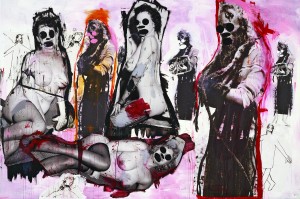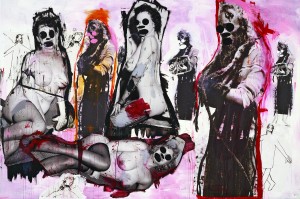
It wasn’t all that long ago that Richard Prince was an artist respected by curators and a few collectors who was largely overlooked by the art market. (He was best known for his 1983 Spiritual America, an unauthorized “re-photograph” of an nude, underage Brooke Shields.) A serious mid-career show at the Whitney in 1992 was filled with his great “Cowboy” and “Girlfriend” series of pictures and his photographs of decrepit upstate motor homes–the sociology of white-trash depravity has always been primary source material. But, in terms of fame and success, years ago I heard he had moved his big studio upstate, to Rensselaer, N.Y., because it was the only place he could afford.
Mr. Prince emerged as part of what the Metropolitan Museum of Art dubbed in a recent show the “Pictures Generation,” an 1980s group of artists that includes Jack Goldstein, Laurie Simmons, Cindy Sherman and Sherrie Levine. Though I don’t believe he invented “appropriation,” he is definitely the most successful practitioner of the technique. It entails taking an image from one place, and creating a work of art by changing its context. Hard to believe, but that’s all he did in many cases, and in so doing, he carved out his own place in art history, as well as disrupting traditional definitions of what constitutes “photography.” This because his “Cowboy” photographs are just pictures of existing Marlboro ads, and his “Girlfriends” are just re-photographed pictures of pages in biker magazines. So his photographs are pictures of pictures; He’s carved his place in art history for that. He gives them new meaning by making us see them out of their original context, which is the thread that holds all his work together: cowboys, girlfriends and what came next.
It was at a Barbara Gladstone gallery show in 2003 that Mr. Prince showed a new body of work: paintings that were based on pulp fiction book covers from the ’50s and ’60s. These were soft-core porny novels like Nightclub Nurse and Man-Eating Nurse. The paintings, priced at $75,000, sold out immediately. By July of 2008, only five years later, Overseas Nurse made almost $8.5 million at auction, a more-than-100-times return on the original investment, making Mr. Prince one of the most expensive living American artists.
By the fall of 08′ he had already left Gladstone and joined Gagosian gallery when he debuted with his apocalyptic “Canal Zone” series. His prices were doubled for this auspicious occasion (new paintings were then priced up to about $3 million), but neither the artist nor his gallery could predict that the world would be entering an apocalyptic financial crisis of its own. The timing couldn’t be worse, so if the artworks of Rastafarians with whited-out eyes and electric guitars as machine guns didn’t scare off most collectors, the prices sure did. Stylistically, the works suggested Bob Marley as a terrorist rampaging through Picasso’s Les Demoiselles d’Avignon. To make matters worse, the Rastafarians had been lifted from a recent book titled Yes Rasta by French photographer Patrick Cariou. The Frenchman didn’t approve of the use of his images out of context, and sued.
On March 18, in U.S. District Court, he won a summary judgment against Richard Prince and Gagosian Gallery for copyright infringement, fair use and liability. (In the lawsuit, we learn that only 8 of 28 paintings found paying clients.) Now a judge has ruled that the entire series is illegal; even worse, it was decided that the gallery must “deliver for impounding and destruction all infringing copies including paintings and unsold copies of the book.” The court went even further, declaring that the “paintings were not lawfully made under the Copyright Act and they cannot be lawfully displayed.”
I always liked the series, and I’m a contrarian, so, in the pit of the crisis (summer 2009), I had bought a big one, and proudly hung it in my living room where many have shown curiosity and some experience serious disapprobation. Did I know about the lawsuit at that time and was I concerned? Yes, it was a perfect Richard Prince scenario: a work that was made under a potential copyright violation, the subject of a lawsuit, by a self-avowed “appropriation” artist.
Now some have mistakenly interpreted the judge’s decision to read that I need to give it back to the gallery, but possession is 9/10′s of the law, and there is a whole chapter in this story yet to been told.
A few days ago, I spoke to Patrick Cariou. He said that he was never offered any settlement money by Prince or his gallery before, during or after the show. He felt that that the artist had exhibited “arrogance, an overwhelming sense of power, and plain laziness.”
The Frenchman was clever to hold out in court, his damages will be substantial and they will be decided on May 6.
But, I wondered: What of his subject matter, the poor Jamaicans living up in the hills. Did they get a modeling fee? Did they give consent to the publication of their likeness for profit? What, if anything, were they paid, and shouldn’t they be entitled to some share of the suit proceeds? Well, Mr. Cariou agreed, he said “absolutely they are, and if I get anything, they will.” It irks him that the images were used out of context, “he (Prince) made them look like zombies, it’s a racist piece of art.” He summarized his views for me: “Hell, No. Fuck Prince, Fuck Gagosian”.
Synonyms for appropriation include stealing, confiscation, seizure, usurpation as well as pilfering. If, as Pablo Picasso (paraphrasing T.S. Eliot) is oft quoted as saying, “Good artists borrow but great artists steal,” then there is no doubt that Mr. Prince is a great one, since he has stolen successfully for years. With the “Canal Zone” series, the law says he went a step too far, taking images out of a book recently in print and without any semblance of concern for ownership of copyright. But the paintings were really good, and as collectors, that’s all we care about. This time, Mr. Prince got busted, but I’m not too concerned for him.
These days, he can well afford it.

Hi, this is a comment.
To delete a comment, just log in and view the post's comments. There you will have the option to edit or delete them.
Thank you for the update and response to this! Great article; I look forward to reading more. Would love to see an image of the piece by Mr. Prince in your collection.